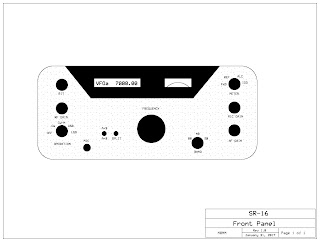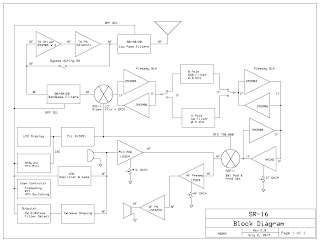Let's face it: The minimalist rigs so popular with the QRP crowd can be a lot of fun to use occasionally, but I know of only a few hardcore individuals who limit their operating to that type of station. I think that I'm fairly typical in that, once the construction's over, I've tended to lose interest fairly quickly and revert back to using commercial equipment.
That's actually been bothering me for the past few years. Sure, I've rationalized this behavior by limiting myself to using only vintage equipment (while my IC-765s languish in disrepair), but I've slowly descended into feeling deeply inadequate and ashamed that, as a red-blooded amateur, I wasn't able to build something suitable for day to day usage. Then it hit me: Why the hell not?
There's an old saying that compares completing a complex project to eating an elephant - it's possible if consumed one bite at a time. Designing and building a rig that'll perform comparably, if not favorably, with commercial products is no different. Before we sit down with fork and knife, we've got to come up with a plan as to how we're going to devour the beast. Pete, N6QW, calls the planning process "noodling". I figure that, at this point in the project, I've done enough noodling to open a pasta factory.
Where to start? The beginning is as good a place as any, so I sat down and thought about what I wanted this rig to do. It was, at this point, where the SR-150 came to mind. I owned one years ago, and have ever since believed that it was the most practical, user friendly rig of the tube era. Now, the SR-150 was a five-band dual conversion transceiver, and with the bottom of the solar cycle looming, I figured it'd be a bit of a waste to spend time building circuitry for bands that will likely be dead for the next few years. The SR-160, on the other hand, was Hallicrafters' "stripped down" version: Single conversion and covering only 80,40 and 20.
Features? Thinking about how I operate, I tend to use very few "bells and whistles". The SR series had RIT, which is essential, but required an outboard VFO to operate splits beyond a few KHz. One of the beauties of modern, microprocessor control is that you're able to implement multiple VFOs via software - so that was a must. Manual and decent AGC were also deemed necessary, as was front panel control over mic gain and metering of the PA current and forward and reflected power.
I debated with myself over adding a notch filter, but nixed the idea after thinking about how little I actually used the ones on my commercial rigs. But, at the same time, determined that fairly broad but decent CW and SSB filters were something I absolutely needed.
So, one night in January, I took my list of features, sat down at the computer and drew-up what I envisioned the front panel of a modern-day version of the SR-160 would look like:
Remarkably, I've changed nothing from that original drawing in the process of bringing the rig to fruition. Guess I got it right the first time. Noodling. Gotta do it.
Next thing that I did was start figuring out the circuitry necessary to bring this monster to life. This involved a lot of reading, some breadboarding of trial modules (more on this later) and several iterations of block diagrams before settling on the one below:
Now that the rig is built, I'm updating the documentation and just today revised the block diagram to reflect the "As-Built" design. Again, noodling paid off as very little changed:
I think that, at this point, I've exhausted the attention span of all but the most focused individuals, so I'm going to save delving into the modularity concept and circuit blocks for another day.



This comment has been removed by a blog administrator.
ReplyDelete